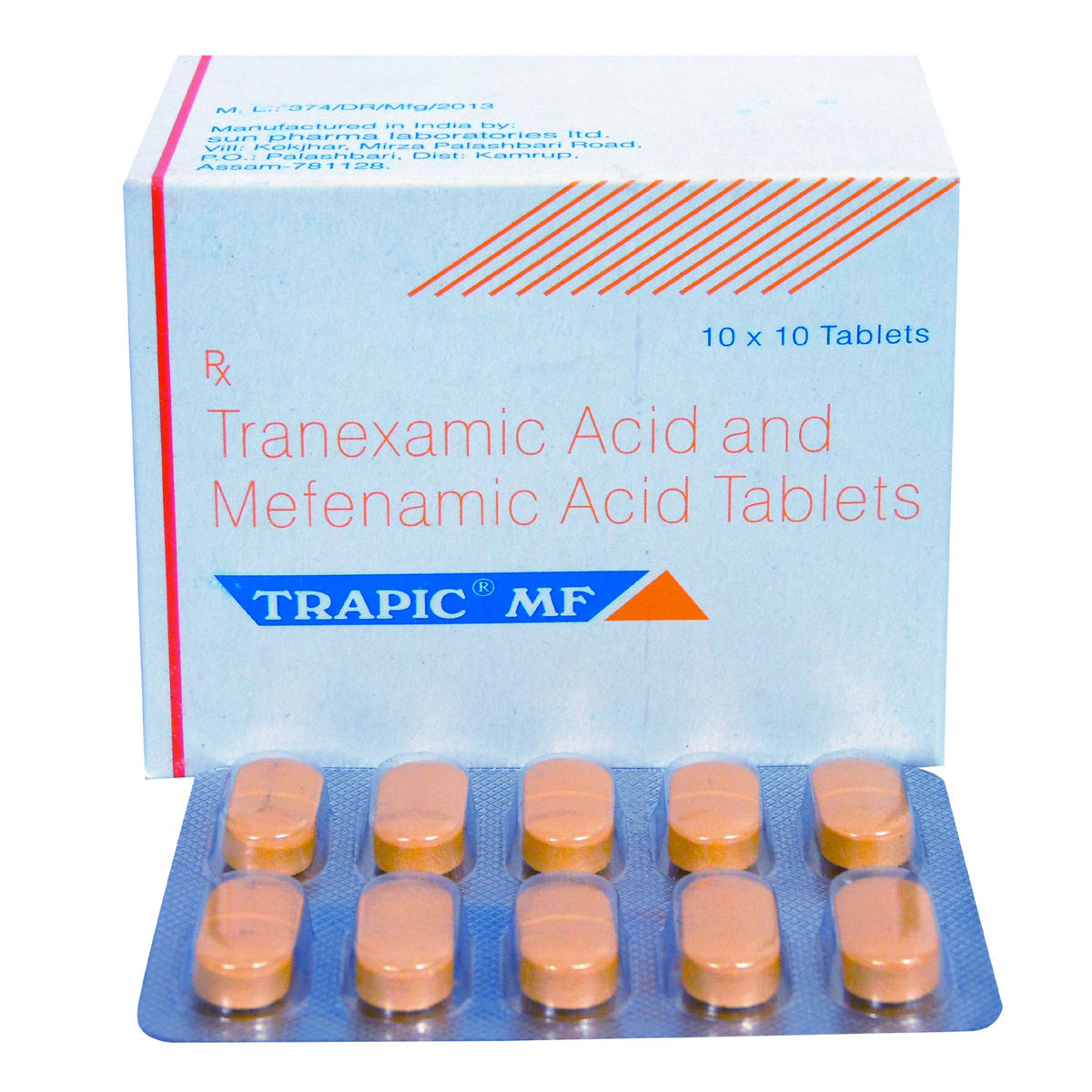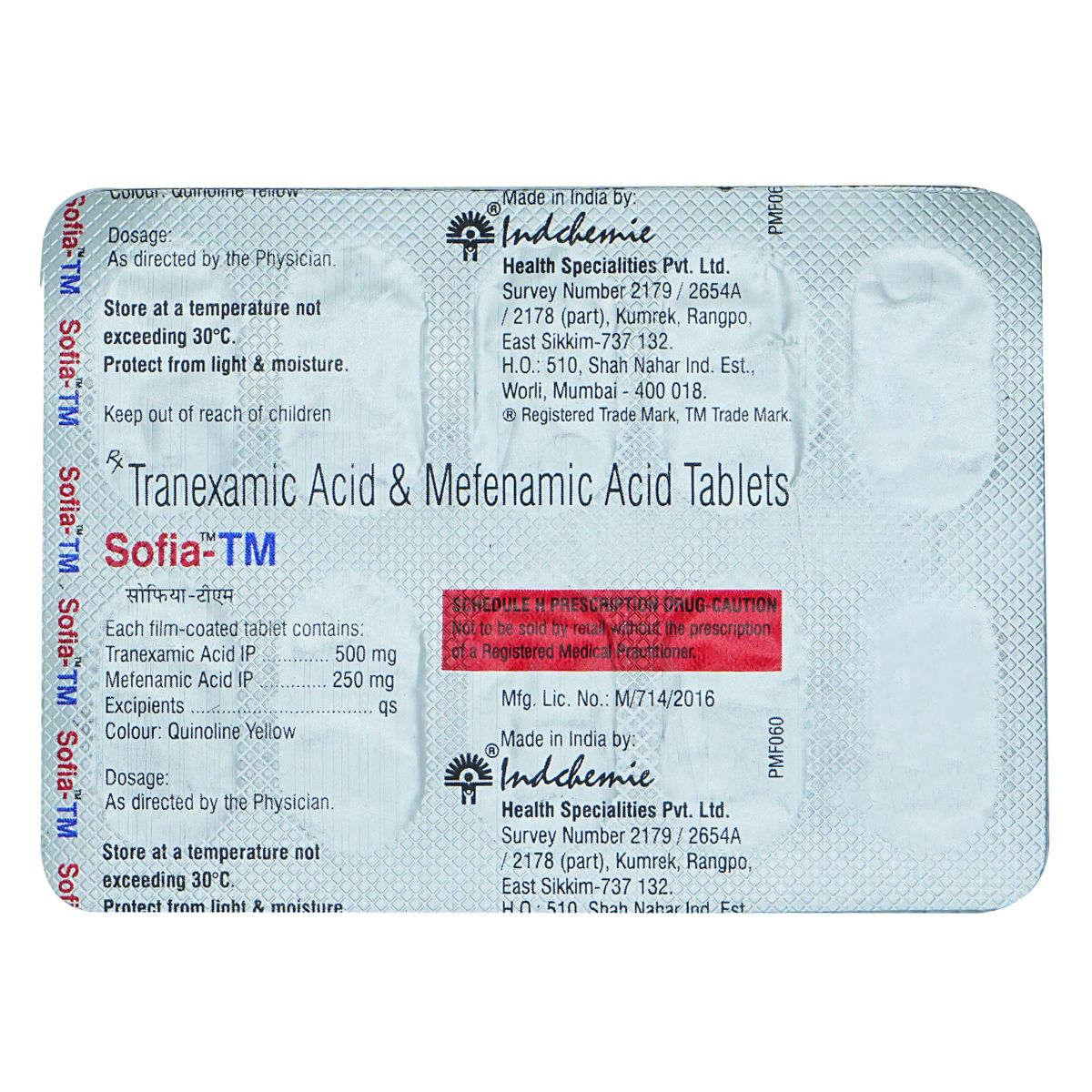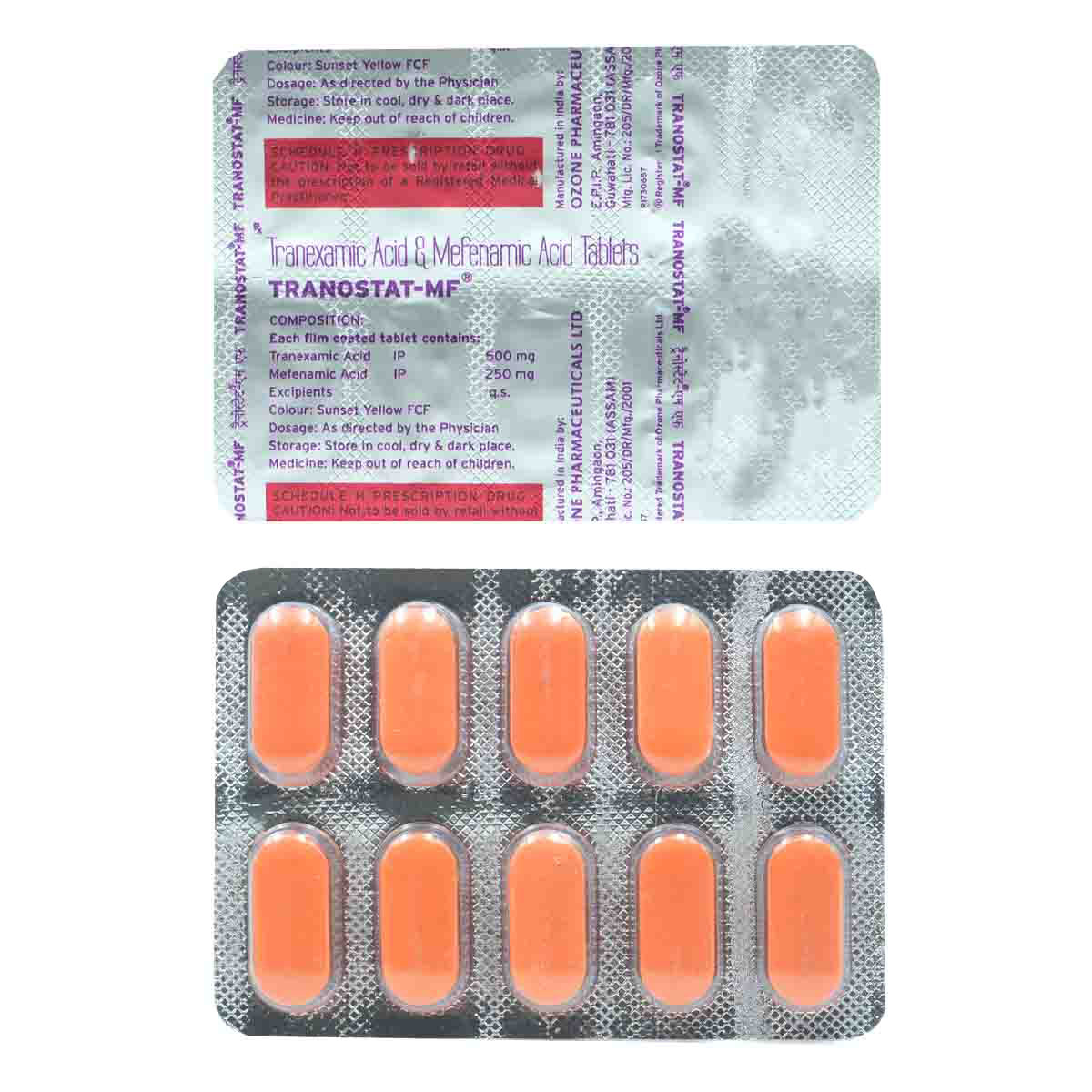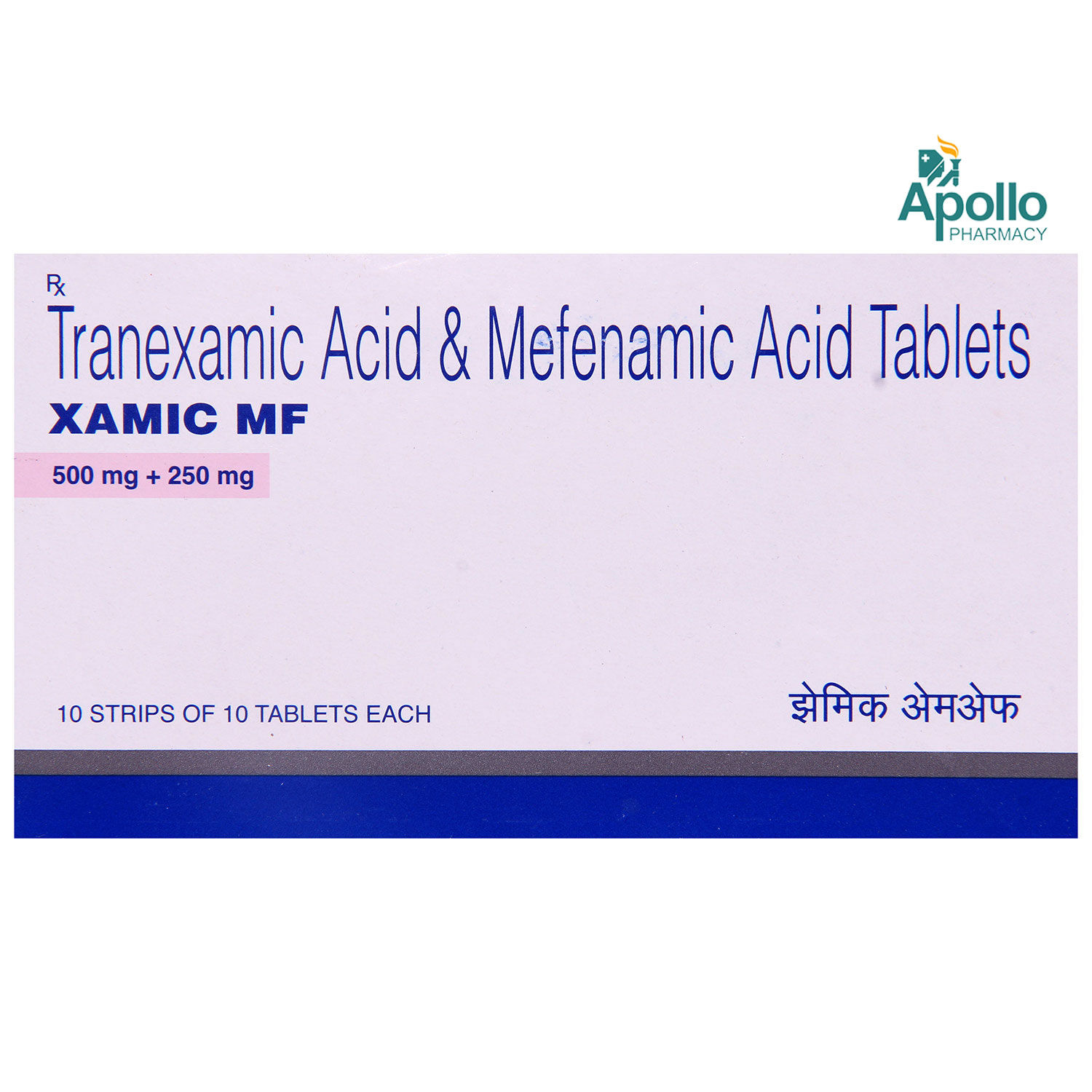Naxamic MF 500mg/250mg Tablet
₹315*
MRP ₹350
10% off
₹297.5*
MRP ₹350
15% CB
₹52.5 cashback(15%)
Free Delivery
With Circle membership
(Inclusive of all Taxes)
This offer price is valid on orders above ₹800. Apply coupon PHARMA10/PHARMA18 (excluding restricted items)
Know Your Delivery Time
Provide Delivery Location

Available Offers
 Prescription drug
Prescription drugWhats That

Secure Payment

India's Most Trusted Pharmacy

Genuine Products
Composition :
Manufacturer/Marketer :
Consume Type :
Return Policy :
About Naxamic MF 500mg/250mg Tablet
Naxamic MF 500mg/250mg Tablet is a combination medicine used to treat dysmenorrhea (period pain) and menorrhagia (heavy menstrual bleeding). Besides this, Naxamic MF 500mg/250mg Tablet is also used to treat severe blood loss, swelling in various body parts, fever, inflammation, and migraine headache. Menstrual cramps, also known as dysmenorrhea, are characterized by cramps and pain during menstruation. Menorrhagia is a condition with abnormally heavy or prolonged bleeding during menstruation/periods.
Naxamic MF 500mg/250mg Tablet is a combination of two drugs: Tranexamic acid (anti-fibrinolytic) and Mefenamic acid (NSAID). Tranexamic acid helps the body's natural blood clot process by preventing fibrin's breakdown, this stops fibrinolysis, a process that stops blood clot formation. Mefenamic acid works by blocking the effect of chemical messengers that cause pain.
You are advised to take Naxamic MF 500mg/250mg Tablet for as long as your doctor has prescribed it for you, depending on your medical condition. In some cases, you may experience certain common side-effects such as nausea, vomiting, diarrhoea, indigestion, heartburn, and headache. Most of these side-effects do not require medical attention and will resolve gradually over time. However, you are advised to talk to your doctor if you experience these side-effects persistently.
Consult your doctor if you are pregnant or breastfeeding. Naxamic MF 500mg/250mg Tablet may cause dizziness, so drive with caution. Naxamic MF 500mg/250mg Tablet should not be given to children as safety and efficacy have not been established. Avoid consuming alcohol along with Naxamic MF 500mg/250mg Tablet as it could lead to increased drowsiness and dizziness, it might also increase the risk of stomach bleeding. Keep your doctor informed about your health condition and medicines to rule out any side-effects/interactions.
Uses of Naxamic MF 500mg/250mg Tablet
Directions for Use
Medicinal Benefits
Naxamic MF 500mg/250mg Tablet is a combination of two drugs, namely: Tranexamic acid and Mefenamic acid. Naxamic MF 500mg/250mg Tablet is used to treat abdominal pain, dysmenorrhea (period pain), and menorrhagia (heavy menstrual bleeding). Additionally, Naxamic MF 500mg/250mg Tablet is also used to treat severe blood loss, swelling in various body parts, fever, inflammation, and migraine headache. Tranexamic acid is an anti-fibrinolytic agent that helps the body's natural blood clot process by preventing fibrin's breakdown, this stops fibrinolysis, a process that stops blood clot formation. Mefenamic acid is an NSAID that works by blocking the effect of a chemical messenger in the body, known as cyclo-oxygenase (COX) enzymes that make other chemical prostaglandins. By blocking the COX enzyme's effect, lesser prostaglandins are produced, which reduces mild to moderate pain and inflammation at the injured or damaged site. Together, Naxamic MF 500mg/250mg Tablet helps treat heavy bleeding and pains/cramps during periods.
How Naxamic MF 500mg/250mg Tablet Works
Storage
Side Effects of Naxamic MF 500mg/250mg Tablet
- Nausea
- Vomiting
- Diarrhoea
- Indigestion
- Heartburn
- Headache
- Musculoskeletal pain
- Stomach pain
What if I have taken an overdose of Naxamic MF 500mg/250mg Tablet
Drug Warnings
Do not take Naxamic MF 500mg/250mg Tablet if you are allergic to any of its contents or if you have severe heart failure. Inform your doctor if you have/had deep vein thrombosis, pulmonary embolism (block a blood vessel in the lungs), coagulopathy (formation of blood clots), epilepsy, irregular periods, heart, kidney, or liver problems. Consult your doctor if you are pregnant or breastfeeding. Naxamic MF 500mg/250mg Tablet may cause dizziness and drowsiness, so drive only if you are alert. Naxamic MF 500mg/250mg Tablet should not be given to children as safety and effectiveness have not been established. Avoid consuming alcohol along with Naxamic MF 500mg/250mg Tablet as it could lead to increased drowsiness and can increase the risk of stomach bleeding. Do not take any other NSAIDs for pain relief along with Naxamic MF 500mg/250mg Tablet unless prescribed.
Drug-Drug Interactions
Drug-Drug Interactions
Login/Sign Up
Taking Medroxyprogesterone acetate with Naxamic MF 500mg/250mg Tablet may increase the risk of blood clots.
How to manage the interaction:
Taking Medroxyprogesterone with Naxamic MF 500mg/250mg Tablet is not recommended but can be taken if prescribed by a doctor. Consult your doctor immediately if you experience symptoms such as chest pain, shortness of breath, coughing up blood, blood in the urine, sudden loss of vision, and pain, redness, or swelling in your arm or leg. Do not stop using any medications without talking to your doctor.
Taking Levonorgestrel with Naxamic MF 500mg/250mg Tablet may increase the risk of blood clot formation which can lead to serious conditions such as heart problems and kidney failure.
How to manage the interaction:
Taking Naxamic MF 500mg/250mg Tablet with Levonorgestrel may leads to an interaction but can be taken if prescribed by the doctor. However, if you experience chest pain; shortness of breath; coughing up blood; blood in the urine; sudden loss of vision; and pain, redness, or swelling in your arm or leg, consult the doctor immediately. Do not stop using any medications without talking to a doctor.
Taking drospirenone with Naxamic MF 500mg/250mg Tablet may increase the risk of blood clot formation.
How to manage the interaction:
Taking Naxamic MF 500mg/250mg Tablet with Drospirenone is not recommended, as it can lead to an interaction but can be taken if prescribed by the doctor. However, If you suffer from chest discomfort, shortness of breath, blood in the urine, blood in the cough, sudden loss of vision, and pain, redness, or swelling in your arm or leg, consult your doctor immediately.
Co-administration of Naxamic MF 500mg/250mg Tablet may cause blood clotting when taken with Etonogestrel.
How to manage the interaction:
Taking Naxamic MF 500mg/250mg Tablet with Etonogestrel is not recommended, as it can lead to an interaction but can be taken if prescribed by the doctor. However, If you suffer from chest discomfort, shortness of breath, blood in the urine, blood in the cough, sudden loss of vision, and pain, redness, or swelling in your arm or leg, consult your doctor immediately.
Taking Ethinylestradiol with Naxamic MF 500mg/250mg Tablet may increase the risk of blood clot formation.
How to manage the interaction:
Taking Ethinylestradiol with Naxamic MF 500mg/250mg Tablet is not recommended, as it can lead to an interaction, but can be taken if a doctor has prescribed it. However, if you suffer from chest discomfort, shortness of breath, blood in the urine, blood in the cough, sudden loss of vision, and pain, redness, or swelling in your arm or leg, consult doctor immediately. Do not stop using any medications without talking to a doctor.
Co-administration of Naxamic MF 500mg/250mg Tablet with Meloxicam together can increase the risk or severity of bleeding.
How to manage the interaction:
Taking Naxamic MF 500mg/250mg Tablet with Meloxicam together is generally avoided as it can result in an interaction, it can be taken if a doctor has advised it. However, if you notice any unusual bleeding or bruising, other signs of bleeding, dizziness, lightheadedness, red or black tarry stools, coughing up or vomiting blood, severe headache, and weakness, you should contact a doctor immediately. Do not stop using any medications without talking a doctor.
Coadministration of Naxamic MF 500mg/250mg Tablet with Ketorolac can increase the risk or severity of gastric bleeding and ulcers.
How to manage the interaction:
Taking Naxamic MF 500mg/250mg Tablet with Ketorolac together can result in an interaction, it can be taken if your doctor has advised it. However, if you notice any unusual bleeding or bruising, other signs of bleeding, dizziness, lightheadedness, red or black tarry stools, coughing up or vomiting blood, severe headache, and weakness, you should contact a doctor immediately. Do not stop using any medications without talking to a doctor.
Co-administration of Chlorotrianisene with Naxamic MF 500mg/250mg Tablet can increase the risk of blood clots.
How to manage the interaction:
Taking chlorotrianisene with Naxamic MF 500mg/250mg Tablet is not recommended due to its increased effects, however, it can be taken only if a doctor has advised it. If you experience symptoms such as chest pain, shortness of breath, difficulty breathing, coughing up blood, sudden loss of vision, pain, and numbness or weakness on one side of the body contact a doctor immediately. Do not discontinue any medications without consulting a doctor.
Co-administration of Estrone with Naxamic MF 500mg/250mg Tablet can increase the risk of blood clots.
How to manage the interaction:
Taking Estrone with Naxamic MF 500mg/250mg Tablet can possibly lead to an interaction, however, it can be taken only if a doctor has advised it. If you experience symptoms such as chest pain, shortness of breath, difficulty breathing, coughing up blood, sudden loss of vision, pain, and numbness or weakness on one side of the body contact a doctor immediately. Do not discontinue any medications without consulting a doctor.
Co-administration of tretinoin with Naxamic MF 500mg/250mg Tablet may increase the risk of blood clots.
How to manage the interaction:
Taking tretinoin with Naxamic MF 500mg/250mg Tablet is not recommended due to its increased effects, however, it can be taken only if your doctor has advised it. If you experience symptoms such as chest pain, difficulty breathing, coughing up blood, sudden loss of vision, pain, and numbness or weakness on one side of the body contact a doctor immediately. Do not discontinue any medications without consulting a doctor.
Drug-Food Interactions
Drug-Food Interactions
Login/Sign Up
Diet & Lifestyle Advise
Follow a healthy diet. Include vegetables, fruits, and whole grains in your meals.
Stay hydrated; drink plenty of water.
Cut down on sugars, salts, spicy food, coffee, and alcohol.
A heating pad can help ease the pain by placing it on the belly or lower back.
Exercise can help ease the pain of menstrual cramps.
Avoid stress by performing meditation or yoga.
Massage your lower back or abdomen to relieve the pain.
Take proper rest.
Habit Forming
Therapeutic Class
Naxamic MF 500mg/250mg Tablet Substitute

Trapic MF Tablet 10's
₹43.65per tabletPause-MF Tablet 10's
₹45.68per tabletTrenaxa MF Tablet 6's
₹48.33per tabletTexakind-MF Tablet 10's
₹28.71per tabletTrenaxa MF Tablet 10's
₹47.88per tablet
Product Substitutes
Alcohol
Unsafe
Avoid consumption of alcohol while taking Naxamic MF 500mg/250mg Tablet as it may cause increased drowsiness. It can also increase the risk of stomach bleeding.
Pregnancy
Caution
Please consult your doctor if you are pregnant or if you have any concerns regarding this; your doctor will prescribe only if the benefits outweigh the risks.
Breast Feeding
Caution
Consult your doctor before taking Naxamic MF 500mg/250mg Tablet if you are breastfeeding, your doctor will decide if Naxamic MF 500mg/250mg Tablet can be taken by breastfeeding mothers or not.
Driving
Caution
Naxamic MF 500mg/250mg Tablet may cause drowsiness and dizziness. Do not drive or operate machinery unless you are alert.
Liver
Caution
Dose adjustment may be needed in patients with liver impairment. Please consult your doctor if you have a liver impairment or any concerns regarding this.
Kidney
Caution
Dose adjustment may be needed in patients with renal disease. Please consult your doctor if you have kidney impairment or any concerns regarding this.
Children
Unsafe
Naxamic MF 500mg/250mg Tablet should not be given to children as the safety and effectiveness were not established.
FAQs
Country of origin
Disclaimer
Author Details
We provide you with authentic, trustworthy and relevant information























